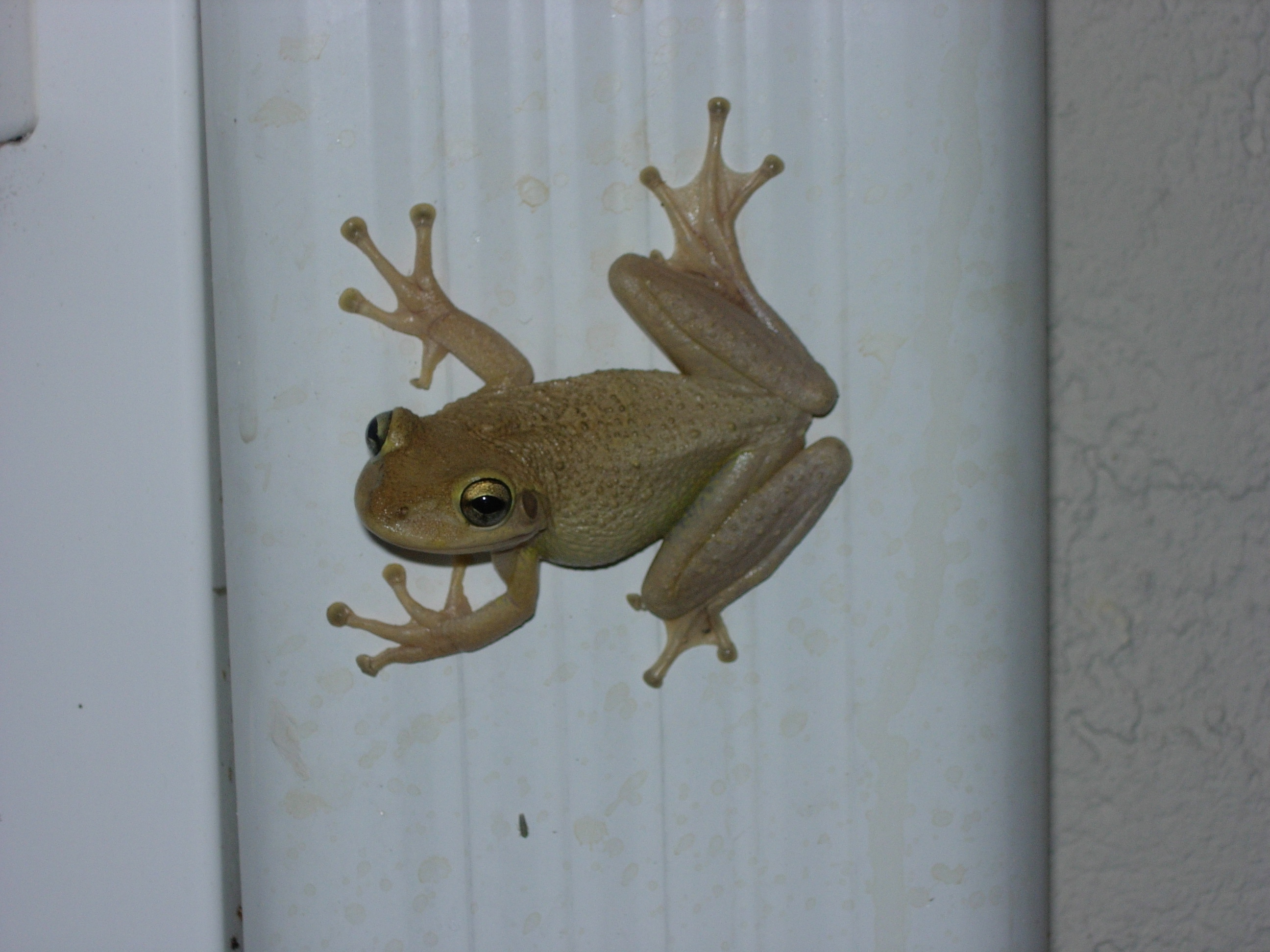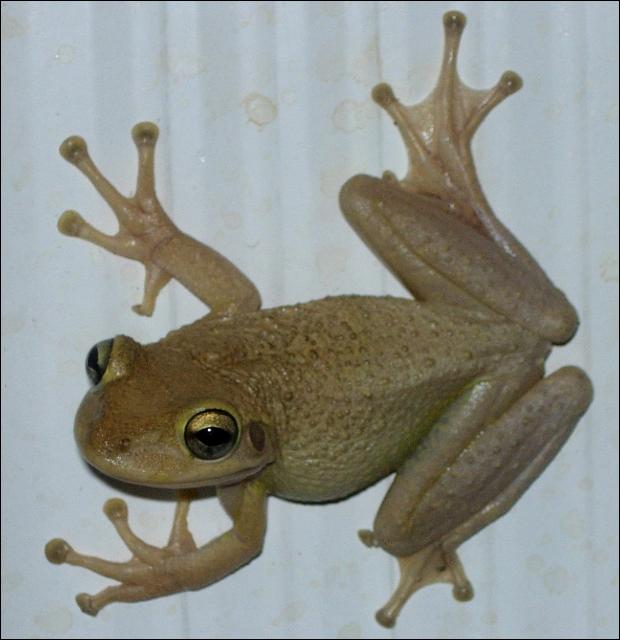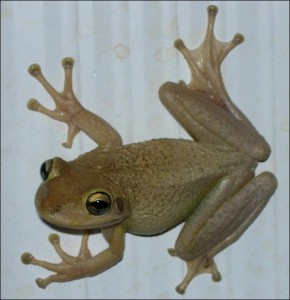
EDRR Invasive Species of the Month – Cuban Treefrog
EDRR Invasive Species
Cuban Treefrog (Osteopilus septentrionalis)
Define Invasive Species: must have ALL of the following –
- Is non-native to the area, in our case northwest Florida
- Introduced by humans, whether intentional or accidental
- Causing either an environmental or economic problem, possibly both
Define EDRR Species: Early Detection Rapid Response. These are species that are either –
- Not currently in the area, in our case the Six Rivers CISMA, but a potential threat
- In the area but in small numbers and could be eradicated
Native Range:
Cuban Treefrog is native to Cuba, Cayman Islands, and the Bahamas.
Introduction:
Accidental introduction in the 1920s most likely by container, or cargo ships.
EDDMapS currently list 1,953 records of this frog. Most are in Florida, and the majority of those in central and south Florida. However, there are records from Louisiana, Georgia, Tennessee, New York, and Massachusetts. Again, most likely cause of spread is hitchhiking on trucks carrying ornamental plants from nurseries in south Florida.
Within our region there are 15 records. 4 in Pensacola Bay area, 3 in Panama City Bay area, 3 from the Tallahassee area, 2 from Crawfordville, and one record from each Crestview, Marianna, and Blountstown.
There is a report of a breeding colony in the Panama City area that has not been confirmed.
There are five records within Six Rivers CISMA. Four in the Pensacola Bay area and one in Crestview.
Description:
Cuban treefrogs are first, treefrogs. Treefrogs can be identified by their large toepads used to hold on to trees and buildings. Cuban treefrog toepads are relatively larger than the native treefrogs.
Adults are much larger than native treefrogs. Local frogs will range from 1-4” but Cuban Treefrogs can reach 6”. They have rough-warty skin, but colors vary greatly. There are usually patterns of dark markings on body, but they do not have the distinct spots of the Barking treefrog. There is a yellowish color where the front and hind legs meet on the body. The eyes can be large and “bugged-out” in appearance.
The most likely native to confuse it with is the Copes gray treefrog. Both have varied colors and warty skin. Both of have the yellow color on skin near where legs join the body. However, the Copes gray treefrog will have a light-colored blotch below each eye. Also, they do not reach the large size of the Cuban treefrog.
Juveniles can be distinguished from natives by having a blueish hue to the color of their skeleton when observed from the belly side of the animal.
Issues and Impacts:
Being larger, the Cuban treefrog has been documented as a major predator of at least five species of native frogs. It is also known to consume small native lizards and snakes. The tadpoles of the Cuban treefrog have been found to out compete those of many native frogs in natural waterways.
Once in the yard, they can form very dense populations that have caused problems with “frogs everywhere”, calling at night (their calls sound like a squeaking door), and invading small ponds, water features, and swimming pools. They like to adhere to walls near lights at night to catch insects and can leave nasty stains on walls and windows. They have been known to take over bird and butterfly houses.
Once inside of the house, they can enter pipes and vents creating clogs and enter the bathroom via the toilet. They have been known to hide in electric panels and are large enough to short-circuit systems causing power outages, air conditioning, and water pump issues.
They are poisonous. And though there are no deaths attributed to them, they can cause an itching-burning sensation in people that can last over an hour. They have caused some pets to go into seizures and foam at the mouth, but no deaths have been reported.
Management:
First you must find them. Being primarily nocturnal, Cuban treefrogs will climb high into trees and spend the daylight hours awaiting sunset. They can crawl into gaps in the wall, under boards and structures, in bird and butterfly houses. One method of capture is to place 3’ sections of 1.5” PVC pipe into the ground near walls where treefrogs gather at night. Many species of treefrogs will use these pipes as hiding places during daylight hours. If there are frogs in the PVC, you can cover the top with a plastic sandwich bag, pull from the ground holding the bottom of the pipe closed with your hand. Have a partner use a stick, or broom handle, and force frogs into the bag. Once there, you can identify them.
If you have a Cuban treefrog (see identification above) there are two methods recommended to euthanize them. 1) You can zip the sandwich bag closed and place in the refrigerator for 3-4 hours. This cooling will numb their nervous system. The bag can then be transferred into a freezer for 24 hours and which time the animal is now dead. 2) Place a 1” strip of benzocaine along their back. Rub this in and wait for the animal to become numb. You can now place back into the bag and into a freezer for 24 hours. REMEMBER, WASH YOUR HANDS AFTER HANDLING A CUBAN TREEFROG. IF YOU GLOVES, WEAR THEM.
It is important to make sure you have identified the frog correctly before euthanizing it. If you have questions, contact your county extension office and have good photos of the animal. If you are in the Florida panhandle area, and it is a Cuban treefrog, please contact your county extension office to let them know and report the siting to www.EDDMapS.org. If you have questions on how to do this, your county extension office can help.
For more information on this EDRR species, contact your local extension office.
References
Invasive Cuban Treefrogs in Florida. Dr. Steve Johnson. University of Florida Department of Wildlife Ecology and Conservation.
https://ufwildlife.ifas.ufl.edu/cuban_treefrog_inFL.shtml.
Cuban Treefrog (Osteopilus septentrionalis) in Florida. Dr. Steve Johnson. University of Florida Department of Wildlife Ecology and Conservation. UF IFAS Extension EDIS publication #WEC218.
https://edis.ifas.ufl.edu/uw259.
Early Detection and Distribution Mapping System (EDDMapS)
Six Rivers CISMA


